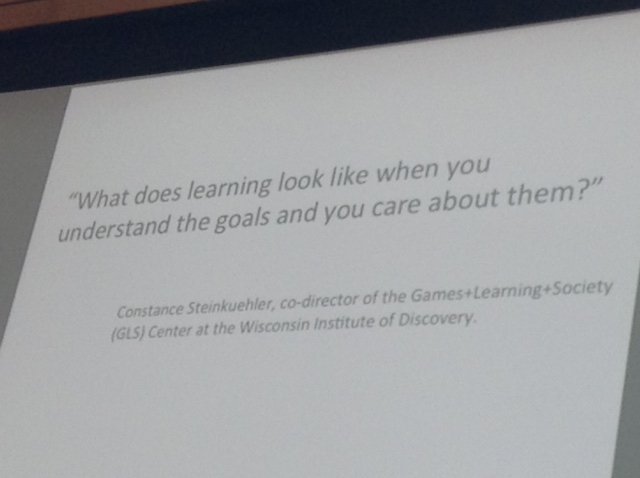Searching for "disrupt"
the use of social media, personal versus institutional, or personal in the context of an institutional repercussions, is a complex and thorny issue. How much can one criticize the institution in their personal social media? And if the institution responds, when does it become silencing the social media as expression of free speech?
Is the article below touching only a specific [political] issue, or academia, as an institution, goes beyond this issue in imposing on freedom of speech?
Why I Was Fired
http://chronicle.com/article/Why-I-Was-Fired/233640
My tweets might appear uncivil, but such a judgment can’t be made in an ideological or rhetorical vacuum. Insofar as “civil” is profoundly racialized and has a long history of demanding conformity, I frequently choose incivility as a form of communication. This choice is both moral and rhetorical.
Academics are usually eager to contest censorship and deconstruct vague charges of vulgarity. When it comes to defending Israel, though, anything goes.
Students are capable of serious discussion, of formulating responses, of thinking through discomfort. They like my teaching because I refuse to infantilize them; I treat them as thinking adults. My philosophy is simple: Teach them the modes and practices of critical thought and let them figure out things on their own.
Professors are often punished for disrupting convention in informal ways, however. My case is interesting because administrators ignored the de facto standards that regulate our behavior and exercised their power directly. This should be worrisome to any scholar who isn’t a sycophant.
The coming of “academic capitalism” has been anticipated and praised for years; today it is here.
Benjamin Ginsberg points out that in the past 30 years, the administrator-to-student ratio has increased while the instructor-to-student ratio has stagnated. The rise of untenured, or non-tenure-track, faculty exacerbates the problem; a significant demographic in academe lacks job security or the working conditions that allow them to maximize their pedagogical talent. Over a recent 10-year period, spending on administration outpaced spending on instruction. At American universities, there are now more administrators and their staffers than full-time faculty. In the past 10 years, administrative salaries have steadily risen while custodians and groundskeepers suffer the inevitable budget cuts — as do the students whose tuition and fees supplement this largess.
When so much money is at stake, those who raid the budget have a deep interest in maintaining the reputation of the institution. Their privilege and the condition of the brand are causally related. The brand thus predominates. Its predominance often arrives at the expense of student well-being.
critical thinking is a terribly undesirable quality in the corporate world, much more damning than selfishness or sycophancy. Let us then be honest about critical thinking: On the tongues of cunning bureaucrats, it is little more than an additive to brand equity, the vainglorious pomp of smug, uptight automatons who like to use buzzwords in their PowerPoint presentations.
Critical thinking by faculty is even more undesirable. In research institutions, we are paid to generate prestige and to amass grant money; in teaching-centered colleges, we enjoy excess enrollments according to fine-tuned equations that maximize the student-teacher ratio. (In elite liberal-arts colleges, we pamper the kids with simulations of parental affection.) Critical thinking is especially harmful to adjuncts, reliant as they are for income on the munificence of well-paid bosses who cultivate a distended assemblage of expendable employees.
more on social media in this IMS blog:
https://blog.stcloudstate.edu/ims/?s=social+media&submit=Search
16 Startups Poised to Disrupt the Education Market
Colleges and universities are facing new competition for customers–students and their parents–from startups delivering similar goods (knowledge, credentials, prestige) more affordably and efficiently. Here’s a rundown of some of those startups.
Related story on the IMS blog:
https://blog.stcloudstate.edu/ims/2014/01/12/cms-course-management-systemsoftware-alternatives/
In a new book, The End of College: Creating the Future of Learning and the University of Everywhere, author Kevin Carey distills a brave new world in which a myriad of lower-cost solutions–most in their infancy–threaten to upend the four-year, high-tuition business model by which colleges and universities have traditionally thrived.
1. Rafter
Using cloud-based e-textbooks and course materials, Rafter helps campus bookstores digitize their offerings and keep their prices low, allowing them to regain the market share they were losing to other stores and course-materials marketplaces.
2. Piazza
Piazza is an online study room where students can anonymously ask questions to teachers and other students. The best answers get pushed to the top through repeated user endorsement.
3. InsideTrack
As do the above two companies, InsideTrack sells its services to universities. It provides highly personalized coaching to students and it helps colleges assess whether their technology and processes are equipped to measure student progress. nsideTrack recently announced a partnership with Chegg, through which it will provide its coaching services directly to students.
4. USEED
If you attended a four-year school, then you know the feeling of receiving relentless requests for alumni donations. USEED is like Kickstarter for school fundraising:
5. Course Hero
One of Inc.‘s 30-Under-30 companies from 2013, Course Hero is an online source of study guides, class notes, past exams, flash cards, and tutoring services.
6. Quizlet
This is another site offering shared learning tools from students worldwide. Quizlet
according to Tony Wan’s superb story on EdSurge.
7. The Minerva Project
Other companies on this list provide services to schools or students. The Minerva Project is, literally, a new school.
8. Dev Bootcamp
In its own way, Dev Bootcamp is also a new school. Its program allows you to become a Web developer after a 19-week course costing under $14,000.
9. The UnCollege Movement
Founded by Thiel Fellow Dale Stephens (who took $100,000 from Peter Thiel to not go to college), The UnCollege Movement provides students with a 12-month Gap Year experience for $16,000.
10. Udacity
Founded by Stanford computer science professor Sebastian Thrun, Udacity creates online classes through which companies can train employees. AT&T, for example, paid Udacity $3 million to develop a series of courses, according to The Wall Street Journal.
11. Coursera
The tagline says it all: “Free online courses from top universities.” Indeed, Coursera’s partners include prestigious universities worldwide.
12. EdX
In a nonprofit joint venture, MIT and Harvard created their own organization offering free online courses from top universities. Several other schools now offer their courses through EdX, including Berkeley, Georgetown, and the University of Texas system.
13. Carnegie Mellon University’s Open Learning Initiative
CMU’s OLI is another example of a nonprofit startup founded by a school to ward off its own potential disruption.
14. Saylor.org
Founder Michael Saylor has been musing on how technology can scale education since he himself was an undergrad at MIT in the early ’80s. Anyone, anywhere, can take courses on Saylor.org for free.
15. Open Badges
Founded by Mozilla, Open Badges is an attempt to establish “a new online standard to recognize and verify learning.”
16. Accredible
Calling itself the “future of certificate management,” Accredible is the company that provides certification services for several of the online schools on this list, including Saylor.org and Udacity.
Academy of distinguished teachers, Innovation
University of Minnesota, McNamara Alumni Center – Twin Cities Campus. April 8, 2015
Full program available here: https://guidebook.com/g/adt/

Randy Bass
Randy Bass
https://www.linkedin.com/pub/randall-bass/14/94/77
flipping disruption into Design
there are two type of universities: the ones that are in control of change and the ones, which are pressed to change.
what kind of education is needed at this moment of history.
Assumptions: 5-10 years will be for a first time outcompeted in terms of delivering information and degrees. What is that the university can do distinctively well that WWW cannot do: mentored learning and the arc of learning (beyond collection of granular separate learning)
book: The New Division of Labor. http://www.amazon.com/The-New-Division-Labor-Computers/dp/0691124027
External forces of potential disruption: 1. MOOCs, nearly free education, 2. skilled-based learning (Codeacademy, Udacity), 3. data analytic 4. public pressure on access, metrics of impact.
Gartner group (http://www.gartner.com/technology/home.jsp) hype cycle : overvalued in a short term and undervalued in a long term. MOOC is excellent example.
NMC: competing models of education.
learning analytics. adaptive learning, intelligent tutoring etc. Open Learning Initative. http://oli.cmu.edu/
In the 19th century, railroads companies which were in the business of railroad companies went under; the ones which were in the business of transportation survived. Parallel, universities, which are in the business of delivering information will die out; the ones, which will survive must look to a very different picture.

formative wider outcomes
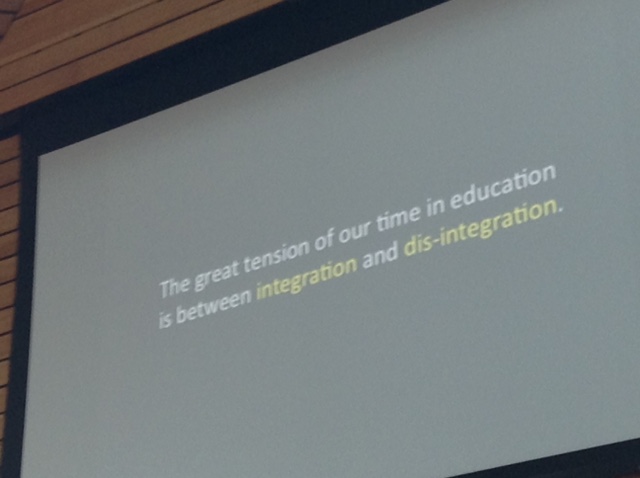
integration and dis-integration
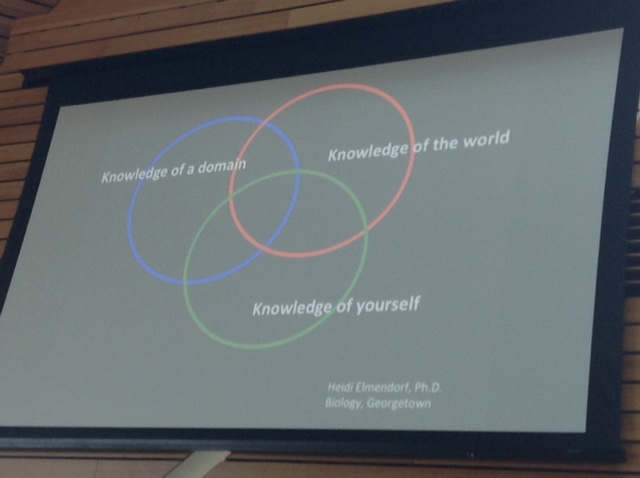
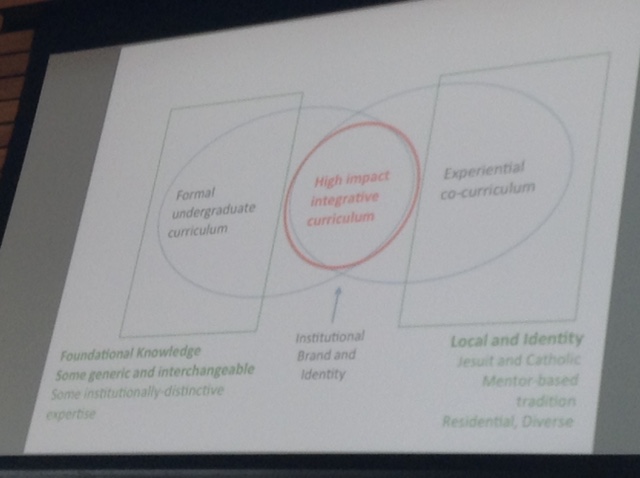
high impact integrative curriculum

what makes high inpact practices high impact
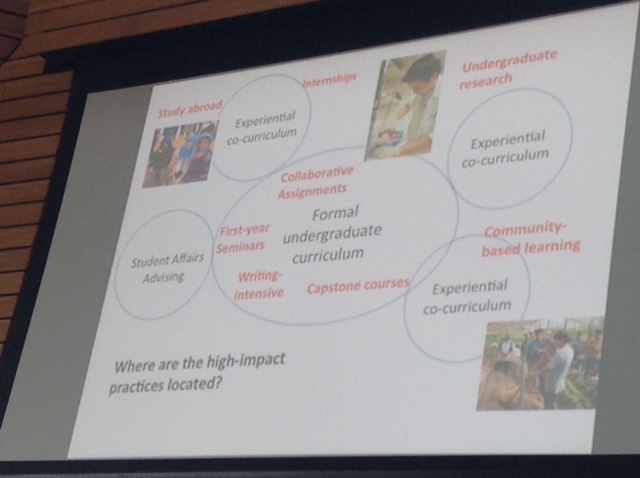
formal versus informal
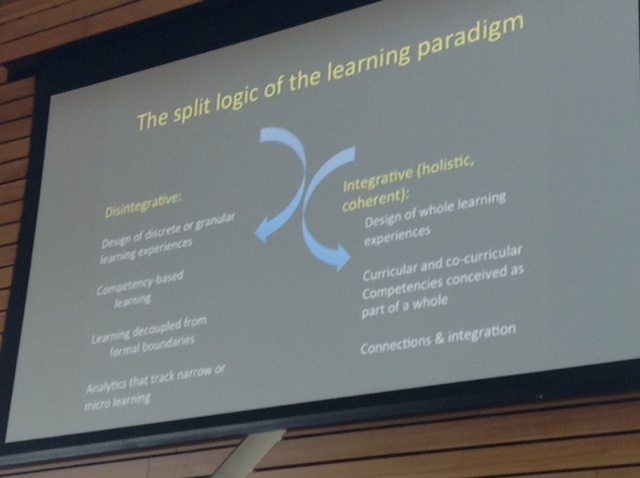
Selected sessions:
The Value of Assessing Outcomes of Teaching Methodologies to guide instructional design
https://guidebook.com/guide/33541/event/10594685/
game-based learning:
Upping your Game – Best Practices in Using Game-Based Learning
https://guidebook.com/guide/33541/event/10594684/
Implementing Game Dynamics in Moodle
https://guidebook.com/guide/33541/event/10693434/
visuals:
Engaging Students through Video Integration
https://guidebook.com/guide/33541/event/10676389/
https://guidebook.com/guide/33541/event/10676375/
Using Flipgrid Video Commentary to Share Student Learning
https://guidebook.com/guide/33541/event/10676361/
————
Enhancing learning with online narrated presentations using VoiceThread
https://guidebook.com/guide/33541/event/10676372/
flipped:
Essential Technology & Tools for Flipping Your Classroom
https://guidebook.com/guide/33541/event/10676385/
Improving Delivery of Technical Course Content through Incremental Use of Classroom “Flipping”
https://guidebook.com/guide/33541/event/10676376/
https://guidebook.com/guide/33541/event/10594850/
The Pros and Cons of Flipping the Classroom
https://guidebook.com/guide/33541/event/10676323/
Using Google Forms for Student Group Evaluations
https://guidebook.com/guide/33541/event/10734863/
Library:
The University Libraries Partnership for Affordable Content – Enhance Student Learning and Save Them Money!
https://guidebook.com/guide/33541/event/10676358/
CRS Tophat:
Using Classroom Debates as an Interactive Learning Tool in a Course on Companion Animal Ethical Issues
https://guidebook.com/guide/33541/event/10676369/
online:
Adapting the Harvard Case Method for Online Courses
https://guidebook.com/guide/33541/event/10595018/
Readiness Assessment for Online Courses
https://guidebook.com/guide/33541/event/10595040/

technology showcase general view
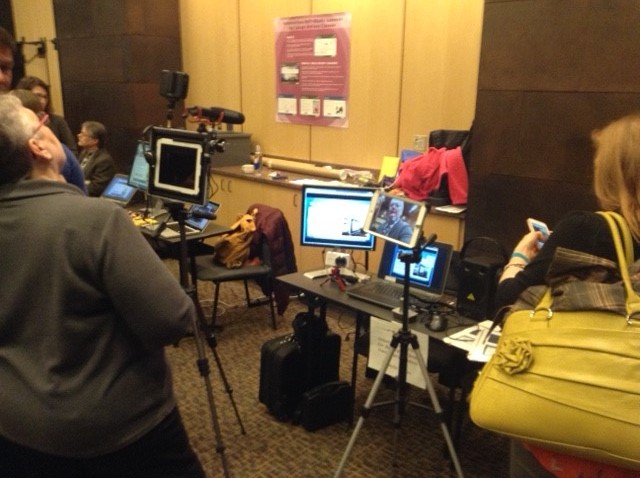
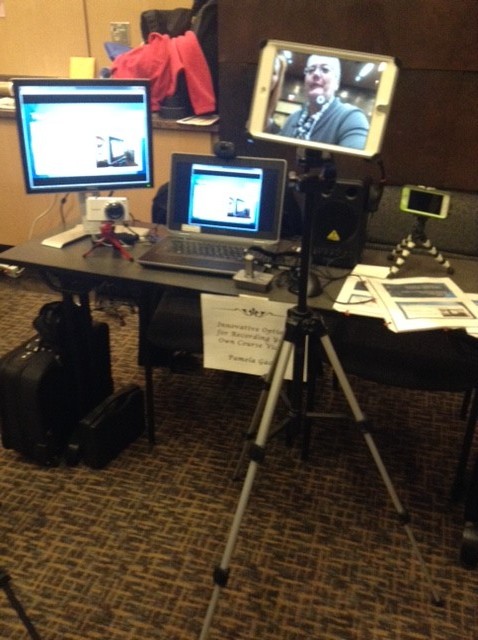
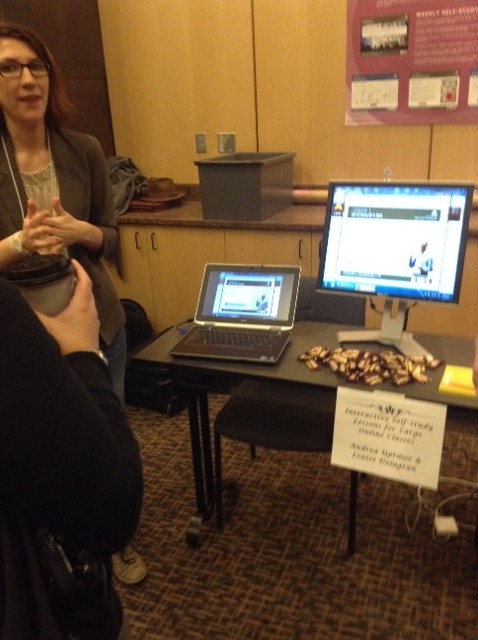


https://www.linkedin.com/pulse/why-we-shouldnt-always-get-lucy-p.-marcus
A bit of disharmony can be very fruitful in a decision-making group. If we are to achieve innovation and disruption, then sometimes we first need discordance and discontent.
But the things that make for a great dinner party are not necessarily the things that make for a good decision-making body. Indeed, in some cases they might be just the opposite.
My note: I see the “dinner party” analogy very much as the “MN nice” analogy. When my previous boss said to me on my second year at SCSU that the foremost goal is to “get along,” my jaw dropped, since my German education and upbringing had taught me that the foremost goal is to “get the job done.”
http://bostinno.streetwise.co/2014/09/24/mit-study-how-do-online-courses-compare-to-traditional-learning/
MIT recently released its final report on what the school’s future will look like, education-wise.
As with any disruptive technology, MOOCs have been viewed with enthusiasm in many quarters and skepticism in some. However, the underlying facts are inarguable: that the rising cost of education, combined with the transformative potential of online teaching and learning technologies, presents a long-term challenge that no university can afford to ignore.
Teaching Is Not a Business
http://mobile.nytimes.com/2014/08/17/opinion/sunday/teaching-is-not-a-business.html
Business does have something to teach educators, but it’s neither the saving power of competition nor flashy ideas like disruptive innovation.
While technology can be put to good use by talented teachers, they, and not the futurists, must take the lead. The process of teaching and learning is an intimate act that neither computers nor markets can hope to replicate. Small wonder, then, that the business model hasn’t worked in reforming the schools — there is simply no substitute for the personal element.
| This email is in regard to a feature within D2L that may be exploited by students to cheat on quizzes and exams.SUMMARY
D2L allows students to re-enter a quiz after leaving the quiz for any reason. This feature is useful for recovering from internet connection problems or other disruptions. This feature can be exploited by two students, one in the classroom and one outside of the classroom, to enter a quiz or exam in quick succession. The second student (the re-entrant student) can then take the quiz on behalf of the student in the classroom while both are connected to the same quiz. The instructor can make such collaboration difficult but cannot completely prevent it. |
 |
ACTIONS
We are actively investigating along with D2L methods of addressing this issue. We don’t expect to be able to completely prevent such behavior due to undesirable consequences for other students, but we are working on detecting it so appropriate notifications can be made and action can be taken quickly.
If you need more information on the issue, prevention, and possible solutions, please contact your local D2L System Administrator or Dick McMullen at dick.mcmullen@so.mnscu.edu or Chuck Morris at Chuck.Morris@so.mnscu.edu.
Sheri Steinke, Ph.D.
Director of Online Learning
Adjunct Faculty CIM & BUSN, CSCI
Certified Quality Matters™ Online Trainer and Peer Reviewer
(952)358-8802
Sheri.Steinke@normandale.edu
D2L: SHARING PRACTICES IN LEARNING AND TEACHING
– mostly it is visual changes. D2L is now using a lot of collapsing / scroll down bars to navigate. it is more compact
– changes and improvements in different tools: e.g. discussion, rubrics, grades (e.g. export straight to Excel), pager etc
– faculty cannot add tools to the default navbar, but can email d2l@stcloudstate.edu and request a tool to be added. Faculty CAN take off tool; don;t forget to save
– must post first in discussion
- 10:00-10:30am: Make D2L work for you: discussions and grades in D2L . Dr. David Switzer, Economics
– grades, how to streamline them. copying again and again in D2L can be too timeconsuming. exxporting to Excel, calculating and importing back is easier. Remeber to export a blank D2L grading item, so the template can be set. q/n: when final grades will be able to export straight from D2L to R&R
-use subscription on discussion
-show students in class that surveys are anonimous indeed
– who to turn for help and ideas: colleagues, tech support, tech insrtruct people, students
– how to organize lectures’ content and put it online, D2L in particular
– F2F, hybrid and online. how do we choose and discriminate?
– online learning, disruptive technology. touched on MOOC, student-center edlearning
– Camtasia. free version of the C Studio 8.0 for Win and Mac. Shareware (30 days). for every min of recorded lecture, will take 5 to 10 min to record it, edit it and prepared it.
– Adobe Captivate. use it through the virtual lab. it is not that connvenient. $30 per year for the key server version
-Blue Berry is superior to Camtesia by allowing to draw
– Jing. Free
– Screencast. bandwidh restriction. means that too many students cannot view simultanously the lecture video. Flash-based and this is not compatible with Apple products.
– Mediaserver (media4.stcloudstate.edu) upload zipped folder (SCORM compliant). Need an account, request from Greg Jorgenson.
— Mike from the Adobe Connect participants shared ” I’ve used Screenhunter to captures images (jpg), which is a free software”
– multimedia formats: video, audio, images, animations
– differences between raster and vector graphics. Camtasia will accept only JPG, PNG formats, but not vectorgraphics
- 11:30-12:00pm: Open time for individual projects and problem solving.
Lunch Break
– Steve: rubrics and grading. D2L is not flexible and we need to adapt our assessment to the D2L capabilities.
– homework and papers, holistic and analytic.
– Amazon Kindle much better for grading online then iPAD.
– separate criteria did not work for Steve, but Ken has his rubrics in different criteria. KISS rule. Properly defines students’ expecations. Create a grid of the rubrics and then cut and paste into the D2L rubrics. Also go over with students over the rubrics details.
– Ken: have several levels in rubrics. New Rubric must be “published” and not a “draft” otherwise cannot be linked to grades.
– calibrated peer review.
another way of using rubrics. potential advantage of using this app is to do automated blind peer review. D2L cannot do it that well as this app. handy for large classes and short writing assignments. Contact Joe Melcher (jmmelcher@stcloudstate.edu) for an account to be created.
crowd control versus really learning the content. The software gives a good feedback what students have actually done (student progress tab).
export callibrated results to D2L
- 2:00-3:00pm: Open time for individual projects and problem solving.
You can also join us via virtual synchronous connection through Adobe Connect at:
http://media4.stcloudstate.edu/d2lworkshop/
Limited space; please consider registering at: https://secure.mnsu.edu/mnscupd/login/default.asp?campusid=0073
We would like similar event during the Spring 2013 semester? Please share with us your preference for day/time, as well as topics of interest.
For any questions, recommendations, suggestions, please use the following contact:
Plamen Miltenoff
320-308-3072
pmiltenoff@stcloudstate.edu



